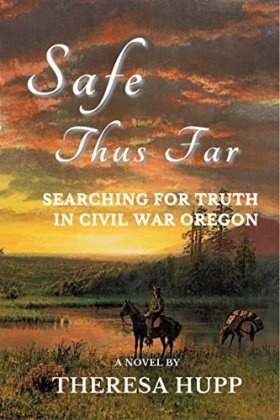“Yes, the real trek doesn’t begin until tomorrow.” He held her close and kissed her.
She breathed in his scent, wishing she could keep him with her, even though she’d urged him to go. After a last hug, she turned Mac toward Daniel, who waited patiently on his mare with a pack mule in tow behind him. “Can Daniel’s mule carry enough food for you both?” Jenny asked, already worrying about Mac as much as William.
Mac leaned over and kissed her again. “I’ll bring Will home safely,” he said, then mounted Valiente to ride to the steamboat dock.
After the men left, Jenny and Maria sat silently in the parlor sewing. Andrew lay in a basket at Jenny’s feet, and Rufus snored and woofed on the floor by Maria. “Penny for your thoughts,” Jenny said to her daughter after a while.
“Just worrying about Pa and Will,” Maria said.
“I am, too.” Jenny sighed. Then she looked at Maria. “Have you ever thought about going back to school? After William returns, of course.”
Maria shook her head. “I didn’t like the girls in town. And they didn’t like me.”
“What if we looked for a school in another town?” Jenny picked up another pair of pants to patch.
“Leave home?” Maria’s voice rose an octave. “Oh, Mama.”
“I don’t want you to go either,” Jenny said. “But we must consider what’s best for your future.”
Andrew let out a muffled cry. “Shh,” Jenny crooned, “you’ll meet your oldest brother soon. Your papa will bring him home. Until then, Maria and I will take care of you.” Then she told Maria, “We won’t decide until Mac and William are back, but I want you to think about it.”

Mac and Daniel rode to the steamboat dock in Oregon City and bought their tickets. They repeated the journey they took earlier in the year after hearing the boys were sighted in Eugene.
The boat trip up the Willamette River was lovely this time of year—the maples and cottonwoods turning bright colors, the autumn air crisp and cool. Mac was glad of his woolen coat and scarf against the chill from the water, but it was a beautiful day to be on the boat.
“How long you reckon it’ll take us to ride to Klamath?” Daniel asked.
Mac shrugged. “A week or ten days. It’s roughly two-hundred and fifty miles from Eugene to Klamath, and we’re both seasoned riders with little baggage.”
Daniel grinned. “Maybe I’m seasoned, but you’re a city man now. Gettin’ soft, I suppose.”
“We’ll see.” Mac clapped Daniel on the back. “I can still ride horseback all day if I have to.”
“And your horse is gettin’ old,” Daniel ribbed Mac further. “Valiente’s over twenty now, ain’t he?”
“I think he’s twenty-three this year.” Mac squinted at his mount. “His muzzle’s turning gray, but his spirit’s strong.”
“How many colts has he sired? The two I bought from you are the best horses I ever had.”
“I haven’t kept count.” Mac chuckled. “It’s hard enough to keep track of the children I’ve fathered.”
Their banter continued as the steamboat headed south.

The boat arrived in Eugene late that afternoon, and after a night in the hotel, Mac and Daniel mounted their horses to head south. They stopped first to talk to the storekeeper who’d spotted Will months earlier. The man had not seen the boys, nor heard anything about them.
“Not surprising,” Mac said, as they remounted after leaving the store. “We know they’re out in the field with Colonel Drew.”
They rode south out of town. Pushing hard that first day, the two men made twenty-five miles before stopping to camp in a glade along the trail. The next day, they rode hard again and reached Roseburg.
“What say I spring for a room in a hotel tonight?” Mac asked.
Daniel chortled. “I said you was goin’ soft. That why you need a bed?”
“You’re almost as old as I am,” Mac said. “Bet you’d appreciate a comfortable bed.”
“Sounds all right,” Daniel said. “Particularly if it comes with a glass of whiskey.”
“I can make sure it does,” Mac said.
As they ate in the restaurant on the hotel’s ground level that evening, Mac asked the waiter how far it was to Fort Klamath.
“It’s a ways,” he said. “But if you move fast, you can make Grant’s Pass in two days. Fort Klamath is another three days or so from there.”
They followed the waiter’s advice, and rode from dawn until dusk for two days, arriving at Grant’s Pass late on their fourth day out from Eugene.
It was another long ride from Grant’s Pass to Jacksonville, but they reached the mining town shortly after sunset on October 12. They went to a saloon in Jacksonville for supper.
“Anyone know anything about Colonel Drew’s expedition?” Mac asked as they were served their meal and whiskey.
The barkeeper shook his head. “They telegraphed from Boise in mid-September, but ain’t been heard from since. Should be close to Fort Klamath by now, I expect.”
“We’re headed to Klamath. How far is it?” Daniel asked.
“’Bout seventy-five miles,” the barkeeper replied. “Maybe a tad more.”

























